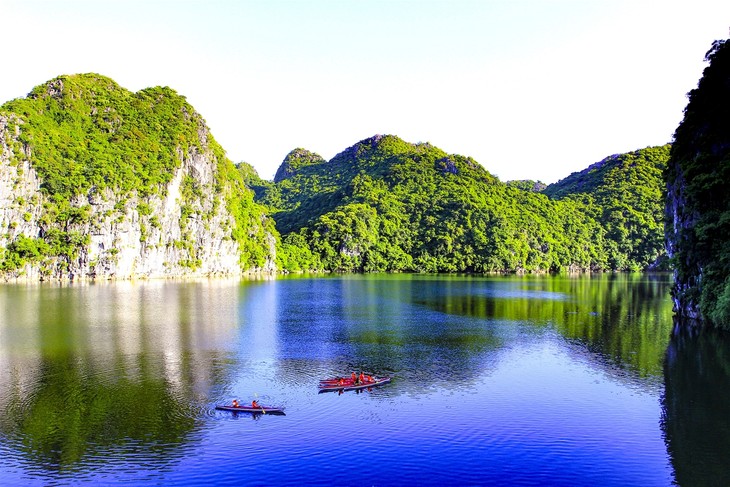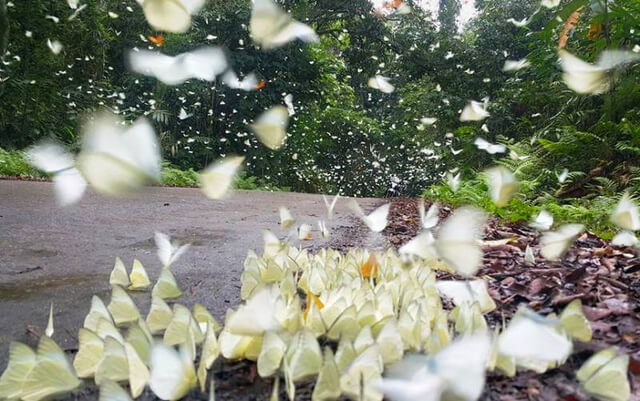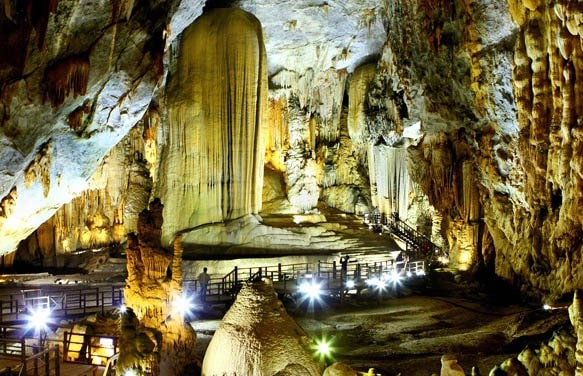A: In an email to VOV this week, Radhakrishna Pillai of India wrote: “My sincere thanks to the Voice of Vietnam English Section for your authoritative and informative programmes. Your programmes are rich with various types of information. I would like to express my gratitude for your Sunday show programme on 20th October. This show provides a clear picture of plastic pollution and its prevention in Vietnam .”
 Langur on Cat Ba island Langur on Cat Ba island |
B: He continued: “It is delightful to know that residential associations, hotels and others are joining this effort. And your reports about a Napalm girl – the most powerful image in 50 years, helping the poor, a beautiful tradition of Vietnam; and the Saturday show on a Vietnamese restaurant in Beijing were very informative. Your various programmes including Economy and Discovery Vietnam about tourism in Vietnam gave me a new experience. Can you tell me about eco-tourism in Vietnam?"
A: Eco-tourism is being widely promoted throughout Vietnam. Today’s Letter Box will mention a few of the top places for ecotours.
B: On beautiful Cat Ba island near Hai Phong city is Cat Ba National Park, a tropical forest with a total area of more than 15,000 hectares. It’s the largest protected marine biosphere, terrestrial forest and mangrove ecosystem in Vietnam. One of the most remarkable animals in this park is the Vooc (white-faced langur). This creature, one of “The World’s 25 Most Endangered Primate Species” is found only on Cat Ba Island.
 Cat Ba National Park Cat Ba National Park |
A: During an ecoholiday here, you can go trekking to Kim Giao Forest, Ngu Lam Peak, Frog Pond, Trung Trang Cave, and Bat Cave. Heart-pumping water sports like kayaking, scuba diving to a coral reef and windsurfing are also available.
B: Cuc Phuong National Park in Ninh Binh province is another popular eco-tourism destination. 140 kilometers south of Hanoi, Cuc Phuong National Park is the oldest nature reserve in Vietnam. Covering an area of 22,000 hectares of rainforest, this place is one of the most attractive ecotourism destinations in northern Vietnam. Its botanical diversity and colorful history attracts not just tourists but many archaeologists.
 Cuc Phuong National Park in the butterflies season Cuc Phuong National Park in the butterflies season |
A: In ‘butterfly season’ from April until the end of May, Cuc Phuong is swarming with butterflies. 280 butterfly species appear in the park landing everywhere, on the road, on your cars, on your helmets... You should visit Cuc Phuong during the dry season from October to April because the roads will be less slippery and you can see many flowers in blooming and swarms of butterflies.
B: Recognized as a UNESCO World Heritage site in 2003, Phong Nha-Ke Bang is located in Bo Trach and Minh Hoa districts of Quang Binh province. This natural park protects a 400-million-year-old limestone karst ecosystem. With its 300 caves and grottoes, Phong Nha is a heaven for adventurous tourists. Some famous caves include Phong Nha Cave, Dark Cave, Tien Son Cave, Thien Duong Cave (Paradise Cave) and Son Doong Cave.
A: This park is one of the most stunning places in Vietnam. It has everything mountains, caves, underground rivers, lakes, and jungles.
 Phong Nha-Ke Bang cave Phong Nha-Ke Bang cave |
B: There are two distinct seasons in Phong Nha: the wet season from September to March and the dry season from April to August. It is more convenient to visit Phong Nha during the dry season. However, June to August is the hottest period, so it’s best to come in April or May.
A: Those are a few of the best places for eco-tours in Vietnam. There are other good ones but in this short program, we can’t mention them all. We’ll continue the list in later shows.
B: In emails to VOV this week, Siddhartha Bhattacharjee of India reported reception of VOV’s English program on the frequency of 7220 khz. In an email sent on October 20, he asked about beaches in Vietnam.
A: Vietnam is known for its many beautiful beaches such as Phu Quoc, Lang Co, Da Nang, and Cat Ba. In a recent issue, Travel + Leisure magazine included Con Son Island among the 13 places with the 'bluest water.'
B: Con Son, the largest and only inhabited island in the 16-island Con Dao archipelago, part of the province of Ba Ria-Vung Tau, beat out more popular beaches in Vietnam like Phu Quoc and Nha Trang to become the only Vietnamese representative on the list.
 Con Son island in Ba Ria-Vung Tau province, southern Vietnam, with crystalline water. (Photo: Shutterstock/An An) Con Son island in Ba Ria-Vung Tau province, southern Vietnam, with crystalline water. (Photo: Shutterstock/An An) |
A: The US magazine called Con Son "an unspoiled island with granite cliffs outlining the crystalline water" where "beaches are lined with golden sand and gorgeous blue water."
B: With Nha Trang, Phu Quoc and Vung Tau now crowded, Con Son, which barely gets a few dozen tourists during the peak travel season, is "one of the best secret islands on Earth."
A: For a unique experience, head to Bamboo Lagoon, an unspoiled lagoon on Con Son’s north shore. Explore the forest, dive down to the coral reef or relax on the beach and watch the day go by. The lagoon is a good camping site and you’ll feel safe to know there’s a forest ranger station nearby.
B: There are a large number of military personnel on the island and little nightlife; so don’t expect any wild parties. Con Son is 230 kilometers southeast of Ho Chi Minh City. Check it out.
A: This week, Richard Nowak of the US expressed an interest in our show on October 28 on the frequency of 7315 khz from 0:00 to 0:27 UTC. He particularly liked the Sunday show’s story about pottery. He wrote: “Materials are soaked and mixed in sand to create the base material. No technology is used. Each product is unique. The pottery is heated at high temperatures for 5-6 hours. Tourists come to the village to see the pottery.”
B: Richard said he liked our discussion of a curry dish. “The dish is served at wedding ceremonies. The curry is imported from Malaysia. I love curry. I used to go to a great Indian restaurant in Queens, New York once a month for curry. The restaurant is the Jackson Diner. I have never had the chance to try Vietnamese curry but it sounds delicious.”
A: We’d like to welcome back to VOV James Howlin of Japan. He sent us a reception report for the program on October 27 from 11:34 to 11:57 UTC on the frequency of 9840 khz.
B: Andrew Kuznetsov of Latvia said he listened to our broadcast from 16:00 to 16:28 on 7220 khz and 7280 khz on October 9 and reported weak signals on both frequencies with SINPO between 3 and 4.
A: Thank you, Mr. Kuznetsov, for your detailed reports. We’ll forward your technical comments to our technicians and ask them to improve the transmission. We hope to receive more feedback from you.
B: This week, we acknowledge reception reports from Shyamal Kumar Banerjeep, Mr. Tapan Basak, M.S Sreenivasa Raju, Mr. D. SARKAR, Madhab Chandra Sagour, and Miss Karobi Hazarika of India. H.M.Tarek, Nusrat Zahan, Faria Khanam Mumu, Feoana Rahman, and Amena Khanam Sale of Bangladesh, Eddy Prabowo of Indonesia, and M Saleem Akhtar Chadhar of Pakistan.
A: Thank you all for tuning in to VOV’s English program and sending us your feedback. We’ll send you QSL cards to confirm your reports. We welcome your letters at English Service, VOVWorld, Voice of Vietnam, 45 Ba Trieu Street, Hanoi, Vietnam. Our email address is englishsection@vov.org.vn. Thank you for listening to VOV on shortwave and following us online. Goodbye until next time.